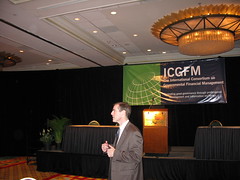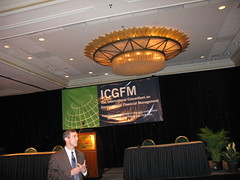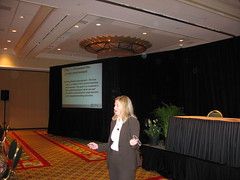
Mike Ablowich of the US Department of the Treasury, Office of Technical Assistance, discussed government cash forecasting at the 24th Annual ICGFM Conference. Cash forecasting can be used as the basis for evaluating strategic financial policy objectives. He described the entire budget planning and execution lifecycle. He emphasized the importance of cash flow forecasting during budget execution.
Cash flow planning and forecasting synchronizes revenue estimates and spending plans according to Mr. Ablowich. The budget is built in law. But, the budget is different from the authority to spend. This results in a need for a coordinated effort to make sure that resources are available when needed to properly execute the budget and meet the needs of a variety of budget stakeholders. Mr. Ablowich pointed out that cash flow forecasting may or may not be done in conjunction with the process of preparing allotments and apportionments. He pointed out that if a strong system is in place to control spending rates then some cash flow forecasting functions presented are not entirely applicable.
Financial & Treasury Control includes comparing actual cash flows to estimates including asset and liability management to shorten "float." Mr. Ablowich said that preparing cash flow estimates will lead to improvements in the collections and disbursement processes and reduce the cost of funds. He advocates Net Present Value (NPV) analysis even though not all NPV concepts are applicable to the public sector.
Mr. Ablowich addressed liquidity management. He pointed out that liquidity management requires forecasting the cash position to manage maturities and issuance of investments and debt. In other words, "Do I have the right amount of cash when I need it?"
Cash Flow Forecasting ProcessThe cash flow forecasting process includes selecting forecasting horizons: short term (less than 1 month), medium term (quarterly) and long term (1 year or more). Mr. Ablowich cautions that the longer the forecast horizon, less accurate the forecast. He suggests that it does not make sense to spend time doing a daily forecast for a year from now.
Mr. Ablowich recommended coordinating many participants in cash forecasting such as spending units, central banks, macro-economic planning, treasury and budget.
It is important to remember that the Treasury, according to Mr. Ablowich, in the initial stage of the preparation of a cash flow statement, has to act as an impartial assembler of information to coordinate the preparation of a cash flow forecast. For that reason the forecast must tie back to the budget, otherwise other agencies or stakeholders will believe that the treasury is trying to alter or make judgments about the budget that has already been passed by the legislature. He pointed out that budgets are typically provided on a cash basis, so this should flow nicely into the cash forecast.
Mr. Ablowich recommends using the 80 - 20 rule. He said that this is the most important slide in his presentation to remember. 80% of revenue comes from 20% of the sources. VAT and customs taxes typically represent the 80% of government revenues. Some countries generate significant revenue from resources. Therefore, more time needs to be spent on sources that generate 80% of the revenue.
Cash Forecasting MethodologiesMr. Ablowich described different cash forecasting methodologies. He described forecasting on afund or agency basis. The choice has to be rational and be supported by the cost/benefit of different planning, collection and forecasting techniques. If a strong I.T. system exists for compiling and synchronizing spending plans then the agency approach might make the most sense according to Mr. Ablowich. If there are three or four major fund groups of equal size then it may make sense to approach this on a fund basis.
Mr. Ablowich described forecasting on an economic or functional basis. Using the economic classification likely lends itself to the easiest forecast to compile and analyze. The functional approach is likely not needed if realistic plans are prepared by agencies on an economic classification basis.
Mr. Ablowich warned that there will always be different degrees of certainty about cash flows. Less predictable cash flow should be considered in risk management, according to Mr. Ablowich. He suggests that payroll represents a certainty for payment. But, large payments on construction projects are less certain.
The types of information sources were discussed by Mr. Ablowich. Integrated Financial Management Information Systems are a data source. The information sources need to be analyzed: cash vs. accrual accounting, treasury single account vs. multiple bank accounts, and methods of budget execution.
Cash Flow Forecasting and Budget ManagementMr. Ablowich discussed revenue forecasting. Budgets should be the source reference. A bad budget will lead to a bad cash flow forecast especially if the revenue estimates are poor from the beginning. The initial budget revenue estimate must be backed by some consistent, corroborating macroeconomic analysis.Weekly or daily estimates of the monthly plan can be prepared using historical daily data lined up against “payment due dates”. Some payments are affected by seasons.
Expenditures can be analyzed based on spending plans and historical trends according to Mr. Ablowich. The past is usually the best predictor of the future in countries with mature financial and budgetary systems. The past can be the best predictor of the future in countries with young financial and budgetary systems if information can be “normalized” for the current year’s situation. He pointed out that governments must be able to predict payroll and pensions payments. He also pointed out looking at the calendar for patterns. For example, standard payments of one source may be made every Friday. Some months have 5 Fridays.
Mr. Ablowich discussed the impact of assets and liabilities on cash forecasting. He introduced how other balance sheet accounts need to be examined for forecasting. He showed spreadsheets from Zambia and Madagascar as examples. He suggested that long-term forecasts require larger teams from throughout the government.
Cash Forecast VariancesThere are numerous factors that can be responsible for variances between forecasts and actuals according to Mr. Ablowich. These include:
- Economic growth higher or lower relative to assumptions
- Economic conditions leading to increased borrowing costs or higher investment earnings
- Inflation rates higher than expected leading to higher rates of growth in indexed payments.
- Disasters/Emergency Situations
- Foreign Exchange
Mr. Ablowich pointed out that legal issues can affect cash flow variances including:
- Changes to tax laws by legislature that effect revenue collections.
- Payouts of settlements of court cases.
- Court interpretations of existing tax laws or spending mandates.
- Sharing ratio of taxes between levels of government.
Understanding and Measuring "Float"Details about understanding and measuring "float" was presented by Mr. Ablowich. He provided clear definitions:
Collection Float- Mail Float: the delay between the time a check (payment) is mailed and it is received.
- Processing Float: The delay between the time a payment is received and it is deposited.
- Availability Float: The delay between the time a payment is deposited and the time the account is credited.
Disbursements Float- Mail Float: The delay between the time a check is mailed and the date the check is received.
- Processing Float: The delay between the time the payee receives the check and the time the check is deposited.
- Clearing Float: The delay between the time the check is deposited and the time it is presented to the payor’s bank for payment.
Mr. Ablowich described float analysis in cash management. The purpose of analyzing disbursement and collections float is to shorter this float to as few days as possible. Decreased costs will come in the form of higher interest earnings, avoidance of interest costs and fewer errors in processing. Decreasing process time should also lead to improved internal efficiencies and improved customer service according to Mr. Ablowich. Cutting down the time for funds to go from point A to point B and having information systems tracking this information every step of the way will lead to decreased costs. Shortening disbursement or collections float will likely be the result of using improved banking products or making changes in internal administrative processes.
Float is measured as:
Average Daily Float = Total Dollar Days of Float/Total Calendar Days in Period
Annual Cost of Float = Average Daily Float * Opportunity Cost of Funds
 Mike Ablowich of the US Department of the Treasury, Office of Technical Assistance, discussed the managing of cash inflows and Outflows at the 24th Annual ICGFM Conference in Miami Florida. The presentation formed part of the workshop on government cash management.
Mike Ablowich of the US Department of the Treasury, Office of Technical Assistance, discussed the managing of cash inflows and Outflows at the 24th Annual ICGFM Conference in Miami Florida. The presentation formed part of the workshop on government cash management.






